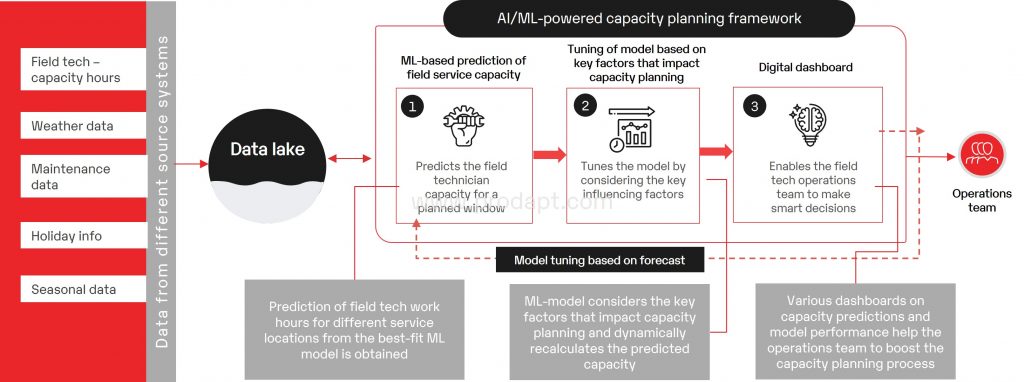This Industry Viewpoint was authored by Boominathan Shanmugam of Prodapt Systems
Most service providers in the connectedness industry are challenged with the planning and allocation of field technicians based on demand. Gartner states, “Balancing available resources against the demand is essential to successful initiative completion.” Based on the engagements with various service providers, the common challenges in traditional field service capacity planning are listed below.
- Unavailability of tools to estimate capacity in real-time
- Lack of strategy to identify the key influencing factors that impact the capacity planning process
- Lack of mechanisms to assign the right technician for the right service
- No end-to-end visibility into field service capacity
Inefficient capacity planning often leads to the over-staffing or under-staffing of field technicians, resulting in order fallouts, missed SLAs, and dissatisfied customers. Hence, service providers need to embrace AI/ML techniques in field services to reduce resource wastage by 20% and improve the effectiveness of service response and customer satisfaction.

Fig 1. Leverage AI-powered capacity planning for modernized field services
This article elaborates on the three-step process that can be adopted by service providers to leverage AI capabilities in field services for efficient capacity planning.
Implementing AI-powered capacity planning for modernized field services
- Predict the field service capacity using the ML model
Identifying the required field service capacity for each service location is primary for seamless service delivery and fulfillment of customer service requests. Implement an ML model to forecast the field technician’s work hours for the next 3 months based on the historic data. As different models can handle different data sets, implement multiple models like NeuralProphet and ARIMA plus model to achieve better predictions. Once the output from the models are received, implement an intelligent ranking system to evaluate the performance of the models through the forecast window. Rank the models based on accuracy and finalize the work hour prediction from the model with the highest accuracy. Intelligent capacity prediction by choosing the best-fit model avoids field technician biasing and improves the model accuracy.
- Tune the model based on the key factors that impact capacity planning
The field service capacity prediction can be affected by various factors such as weather, maintenance data, and holidays. These conditions vary based on the service locations, and field technicians may not be able to access the location during extreme weather conditions. This might result in resource wastage and incomplete service requests. Hence service providers should implement a weather processor to obtain and feed the model with the key influencing factor like weather signals. Based on the weather signal type, recalculate the required field tech work hours using the ML model. The dynamic calibration of the predicted capacity considering the impact of key influencing factors helps reduce resource wastage by 20%.
- Develop a digital dashboard to boost the capacity planning process
Build a digital dashboard to track the available capacity for different service locations and plan for the dispatches. Develop an operations dashboard focusing on SLA adherence for manual and ML capacity predictions. This helps the field tech operations team to focus on areas where SLA adherence is less than 90% and fine-tune the model. Further unique reports on accuracy distributions and performance of models can be developed to provide in-depth visibility of how different models perform for each service location. It enables the operations team to make smart decisions and boost the capacity planning process.
Conclusion
By leveraging AI-powered capacity planning, service providers in the connectedness industry can achieve the following benefits:
- 20% reduction in resource wastage
- 90% achievement of SLA compliance
- 25% more cost savings across field operations
- Improvement in customer experience
I appreciate the efforts of my colleague Priyankaa A- Analyst, Strategic Insights, for her contribution and continuous support in shaping this article.
If you haven't already, please take our Reader Survey! Just 3 questions to help us better understand who is reading Telecom Ramblings so we can serve you better!
Categories: Industry Viewpoint






Discuss this Post